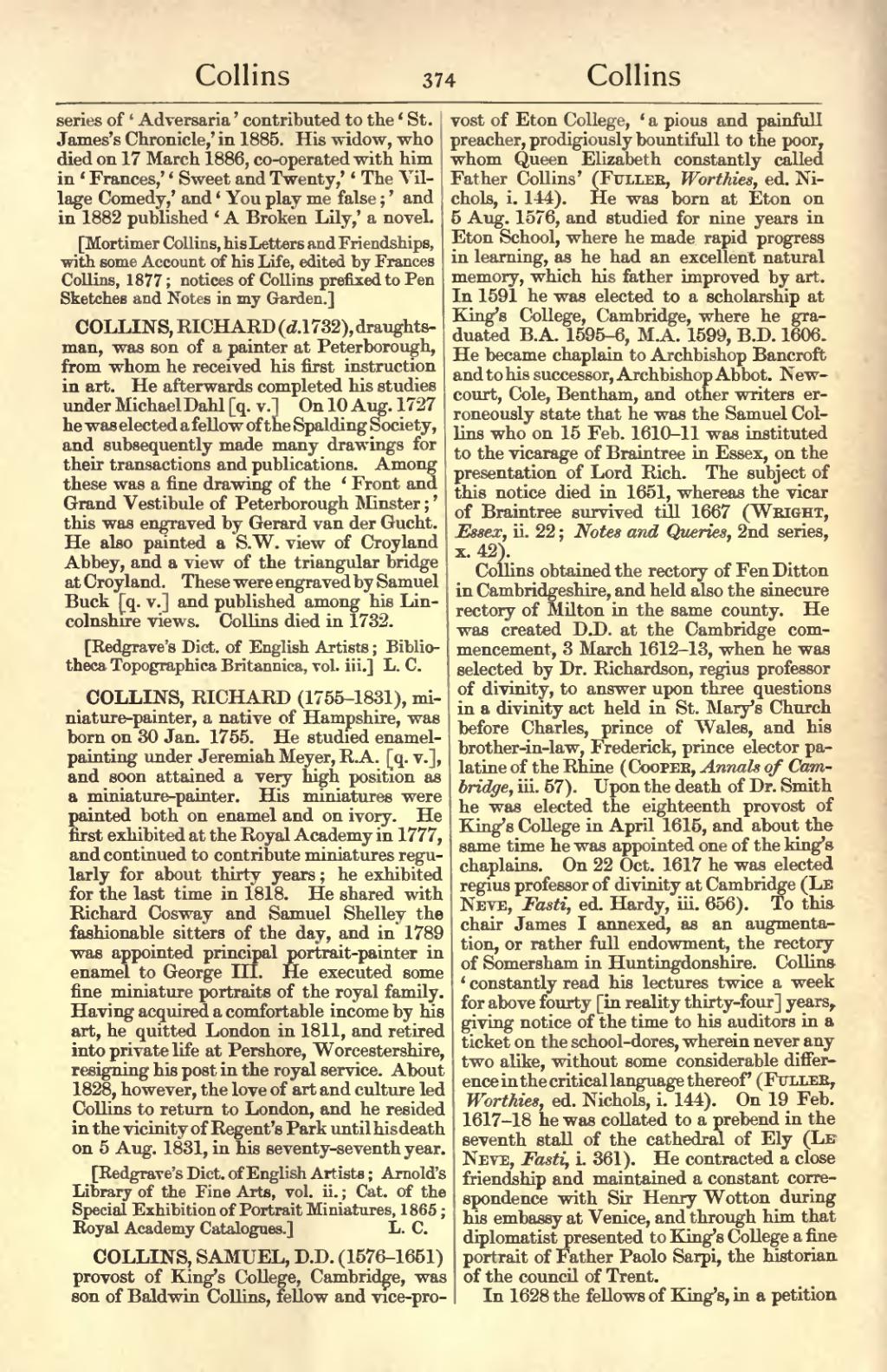series of 'Adversaria' contributed to the 'St. James's Chronicle,' in 1885. His widow, who died on 17 March 1886, co-operated with him in 'Frances,' 'Sweet and Twenty,' 'The Village Comedy,' and 'You play me false;' and in 1882 published 'A Broken Lily,' a novel.
[Mortimer Collins, his Letters and Friendships, with some Account of his Life, edited by Frances Collins, 1877; notices of Collins prefixed to Pen Sketches and Notes in my Garden.]
COLLINS, RICHARD (d. 1732), draughtsman, was son of a painter at Peterborough, from whom he received his first instruction in art. He afterwards completed his studies under Michael Dahl [q. v.] On 10 Aug. 1727 he was elected a fellow of the Spalding Society, and subsequently made many drawings for their transactions and publications. Among these was a fine drawing of the 'Front and Grand Vestibule of Peterborough Minster;' this was engraved by Gerard van der Gucht. He also painted a S.W. view of Croyland Abbey, and a view of the triangular bridge at Croyland. These were engraved by Samuel Buck [q. v.] and published among his Lincolnshire views. Collins died in 1732.
[Redgrave's Dict. of English Artists; Bibliotheca Topographica Britannica, vol. iii.]
COLLINS, RICHARD (1755–1831), miniature-painter, a native of Hampshire, was born on 30 Jan. 1755. He studied enamel-painting under Jeremiah Meyer, R.A. [q. v.], and soon attained a very high position as a miniature-painter. His miniatures were painted both on enamel and on ivory. He first exhibited at the Royal Academy in 1777, and continued to contribute miniatures regularly for about thirty years; he exhibited for the last time in 1818. He shared with Richard Cosway and Samuel Shelley the fashionable sitters of the day, and in 1789 was appointed principal portrait-painter in enamel to George III. He executed some fine miniature portraits of the royal family. Having acquired a comfortable income by his art, he quitted London in 1811, and retired into private life at Pershore, Worcestershire, resigning his post in the royal service. About 1828, however, the love of art and culture led Collins to return to London, and he resided in the vicinity of Regent's Park until his death on 5 Aug. 1831, in his seventy-seventh year.
[Redgrave's Dict. of English Artists; Arnold's Library of the Fine Arts, vol. ii.; Cat. of the Special Exhibition of Portrait Miniatures, 1865; Royal Academy Catalogues.]
COLLINS, SAMUEL, D.D. (1576–1651) provost of King's College, Cambridge, was son of Baldwin Collins, fellow and vice-provost of Eton College, 'a pious and painfull preacher, prodigiously bountifull to the poor, whom Queen Elizabeth constantly called Father Collins' (Fuller, Worthies, ed. Nichols, i. 144). He was born at Eton on 5 Aug. 1576, and studied for nine years in Eton School, where he made rapid progress in learning, as he had an excellent natural memory, which his father improved by art. In 1591 he was elected to a scholarship at King's College, Cambridge, where he graduated B.A. 1595-6, M.A. 1599, B.D. 1606. Se became chaplain to Archbishop Bancroft and to his successor, Archbishop Abbot. Newcourt, Cole, Bentham, and other writers erroneously state that he was the Samuel Collins who on 15 Feb. 1610-11 was instituted to the vicarage of Braintree in Essex, on the presentation of Lord Rich. The subject of this notice died in 1651, whereas the vicar of Braintree survived till 1667 (Wright, Essex, ii. 22; Notes and Queries, 2nd series, x. 42).
Collins obtained the rectory of Fen Ditton in Cambridgeshire, and held also the sinecure rectory of Milton in the same county. He was created D.D. at the Cambridge commencement, 3 March 1612-13, when he was selected by Dr. Richardson, regius professor of divinity, to answer upon three questions in a divinity act held in St. Mary's Church before Charles, prince of Wales, and his brother-in-law, Frederick, prince elector palatine of the Rhine (Cooper, Annals of Cambridge, iii. 57). Upon the death of Dr. Smith he was elected the eighteenth provost of King's College in April 1615, and about the same time he was appointed one of the king's chaplains. On 22 Oct. 1617 he was elected regius professor of divinity at Cambridge (Le Neve, Fasti, ed. Hardy, iii. 656). To this chair James I annexed, as an augmentation, or rather full endowment, the rectory of Somersham in Huntingdonshire. Collins 'constantly read his lectures twice a week for above fourty [in reality thirty-four] years, giving notice of the time to his auditors in a ticket on the school-dores, wherein never any two alike, without some considerable difference in the critical language thereof (Fuller, Worthies, ed. Nichols, i. 144). On 19 Feb. 1617-18 he was collated to a prebend in the seventh stall of the cathedral of Ely (Le Neve, Fasti, i. 361). He contracted a close friendship and maintained a constant correspondence with Sir Henry Wotton during his embassy at Venice, and through him that diplomatist presented to King's College a fine portrait of Father Paolo Sarpi, the historian of the council of Trent.
In 1628 the fellows of King's, in a petition
